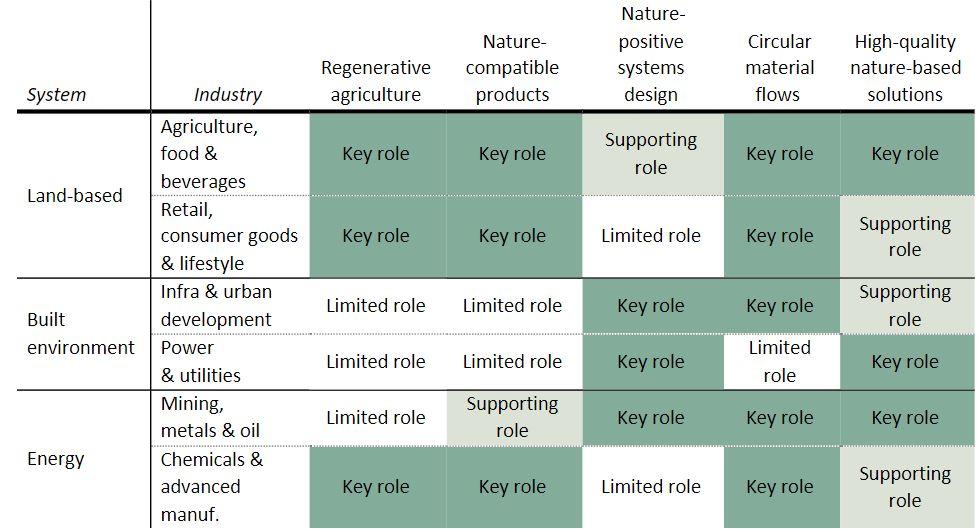Authors
Diane Holdorf, WBCSD, Jenny Davis-Peccoud, Bain & Company
All businesses depend on nature, which we can think about as natural capital assets. The rapid loss of biodiversity puts business resilience at risk, creating the business case for developing plans which take action to halt the loss of nature. In 2019, the Intergovernmental Science-Policy Platform on Biodiversity and Ecosystem Services (IPBES) published a landmark global assessment on biodiversity and ecosystem services, the first of this magnitude in almost 15 years. It told of unprecedented global declines to ecosystems on which people and economies rely for goods, services and quality of life. In 2020, the Dasgupta Review on the Economics of Biodiversity revealed the extent to which nature as an asset is being mismanaged, necessitating a re-set for how natural assets are valued and managed.
As we enter the fifteenth meeting of the Conference of the Parties (COP15) to the Convention on Biological Diversity (CBD), ambitious and urgent action is needed to protect and restore ecosystems. This action is also vital to achieving climate targets. Nature-based solutions are necessary to achieve climate targets when designed to ensure co-benefits for biodiversity.
Business dependencies on natural assets require a risk mitigation framework like the one necessitated for climate, and in preparation for the outcomes of COP15, the Global Biodiversity Framework (GBF) is expected to mandate a business response from materiality assessment through to disclosure. There are promising solutions and guidance for business to take action.
WBCSD, with 60 leading companies and partners, is developing business guidance for corporate action to assess, commit, transform and disclose a company’s dependence on, and impact to, nature. Businesses can take actions now to understand key impacts and dependencies on nature and start addressing nature loss, which mitigate risk, strengthen resilience and identify strategic opportunities.
Business impact on nature
Nature and biodiversity are degrading quickly, with 70% of the world’s ice-free land surface and 66% of our marine environment significantly altered through human activity, and species populations down almost 70% since 1970. More than half of the world’s GDP, USD $44 trillion, is at risk from nature loss by 2030.
Three socio-economic systems have the largest impact on biodiversity loss:
- The food, land and ocean use system (impacting 72% of species under threat*), contributes to deforestation, freshwater exhaustion, water and soil pollution, and habitat destruction through both agriculture and forestry.
- In the infrastructure and built environment system (29% of species threatened), activities drive degradation of land and sea beds, increased flood risk, and water and soil pollution.
- Lastly, in the extractives and energy system (18% of species threatened), mining and oil and gas activities contribute to habitat destruction, landscape alterations, freshwater exhaustion, and pollution.
Mobilizing for change
As with action in response to the climate emergency, global systems are mobilizing to protect and restore nature and biodiversity. The global accountability systems for nature include the UN post-2020 Global Biodiversity Framework, Science Based Targets for Nature (SBTN), Taskforce on Nature-related Financial Disclosures (TNFD), and Global Reporting Initiative (GRI). More information is available in the CEO briefing ‘Measuring Nature-positive Outcomes from Business Actions’.
Immediate corporate action is required, as pressures from regulations and reporting requirements are joined by shifting investor, customer and consumer sentiment. However, in the CDP Climate Change 2022 Questionnaire, only around 25% of surveyed companies indicated they were taking action on nature- and biodiversity-related issues, with only 15% having assessed their impacts.
A recent study by Bain & Company and the World Wildlife Fund (WWF) found three main barriers to business action:
- First, companies are unaware of their impact and exposure; around 60% of companies claim to have no impact on nature and biodiversity, and more than 50% of companies do not perceive biodiversity loss as a significant business threat.
- Second, companies find it challenging to derive concrete value from nature and biodiversity efforts. For example, only around a quarter of companies say they are aware of biodiversity-related business opportunities.
- Third, companies are slowed down by the immaturity of nature and biodiversity as an issue area, with no consistent definitions, reporting standards and metrics to guide progress.
Nonetheless, frontrunners have shown that businesses which do take action can successfully reverse their negative impact on nature and generate business benefits: the potential financial upside for business is currently estimated at USD $10 trillion annually by 2030.
Finding solutions
To catalyze deep value chain transformation, WBCSD is developing roadmaps to nature positive across the three critical systems with a robust approach to guide planning and change.
This structured approach is designed to help businesses define the role of nature and biodiversity in the corporate agenda and initiate actions for material issues. Four steps – assess, commit, transform, and disclose – allow businesses to progress along a maturity curve, with data sources, indicators, tools and resources. Value chain specific guidance will be developed to support implementation based on industry, business and geography, including identification of material impacts and dependencies, to form the basis of commitments and action and related disclosures.
And, there are existing solution sets for outsized progress on nature which also support business success as well as other priorities like the climate transition. Bain has highlighted five in separate research:
- Regenerative agriculture: transforming agricultural practices to improve both yield and ecosystem benefits;
- Nature-compatible products: designing products and services to avoid nature-damaging ingredients and materials and limit overconsumption;
- Nature-positive systems design: incorporating nature considerations into infrastructure and installations to preserve ecosystems;
- Circular material flows and business models: reducing the impact of extraction by addressing quantity of new resources required to satisfy growth;
- High-quality nature-based solutions: restoring and conserving ecosystems to preserve nature and biodiversity, while addressing emissions.
The extent to which a certain business can adopt each of these solutions depends on the socio-economic system and industry in which the business is active:

During 2023, WBCSD in collaboration with its members and partners will release more detailed sector-specific roadmaps for action, incorporating the SBTN and TNFD recommendations. Each company will need to determine how to embed these levers in their own strategic decisions and commercial strategies to ensure that nature-positive actions are also business-positive.
Integrated and collaborative action for nature-positive
The convergence between the climate and biodiversity agenda will drive corporate alignment on target setting and reporting as companies assess their risks and prioritize actions that support nature positive and net zero outcomes. If adopted at scale, the five solution sets outlined here, will contribute to the systems change we need to see, which calls for an investment strategy that integrates across climate and biodiversity needs.
Just as accountability was a strong theme at the 27th Conference of the Parties (COP27) of the United Nations Framework Convention on Climate Change (UNFCCC), it is expected to be central to COP15 discussions. WBCSD engaged its leading member companies to develop a business implementation agenda for COP27, The Business of Climate Recovery: Accelerating Accountability, Ambition and Action. This agenda sets out interventions for accelerating the global decarbonization of business and supports business leaders, in close collaboration with governments, to sharpen accountability, raise ambition, and deliver action at speed and scale. COP15 will establish the same need for collaboration for nature.
But as with climate, business leaders are not merely waiting on government action on biodiversity. The business guidance and nature-positive roadmaps, led by WBCSD and co-developed with companies and key partners including Capitals Coalition and Business for Nature, will offer business ways to accelerate the actions to regenerate the natural assets on which we all depend. These roadmaps build on existing frameworks such as the Natural Capital Protocol (NCP) and embed the use of SBTN and TNFD. As a first step, business can already access a forest sector nature-positive roadmap.
During COP15, to complement the suite of sector-specific roadmaps, WBCSD will release a draft for consultation of the guidance developed with 60 leading companies and partners, “Roadmaps to nature positive: Guidelines to accelerate business accountability, ambition and action for a nature-positive future”. Interested stakeholders can contact WBCSD’s Nature Action Manager, Nadine McCormick.
Some top companies have begun to show the way and there are now promising solutions and guidance to help more to follow their journey. Together, business can help halt and reverse nature loss by 2030 and take action toward a nature-positive future.
* Note: Due to partial overlap between the species impacted by the three systems, the percentage of species impacted by all systems does not add up to 100%. Source, World Economic Forum
WBCSD news articles and insights may be republished in accordance with the Creative Commons Attribution-NonCommercial-NoDerivatives 4.0 International Public License, and in accordance with our Privacy Policy. All Content must be featured with due credits.
Outline

